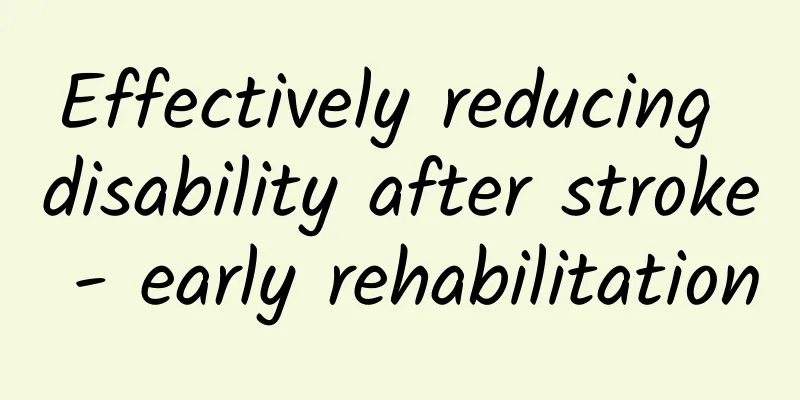Effectively reducing disability after stroke - early rehabilitation

|
Stroke is characterized by high morbidity, high disability and high mortality. There are about 2 million new stroke patients in China every year, of which 70%-80% cannot live independently due to disability. Stroke rehabilitation is the most effective method confirmed by evidence-based medicine to reduce the disability rate. Standardizing rehabilitation procedures and treatment plans is very meaningful in reducing the disability rate of acute stroke and improving the quality of life of patients. The timing and intensity of early rehabilitation for stroke Early rehabilitation for stroke is a concept highly respected by rehabilitation experts, and patients should be able to recover as early as possible if they can tolerate it. Early rehabilitation therapy includes bed range of motion exercises, maintaining good limb positions in bed, bed sitting training, position transfer training, standing training and walking training, etc., and then the activity level is further increased. Early rehabilitation should also include encouraging patients to resume communication with the outside world. The intensity of rehabilitation training is carried out in a step-by-step manner. At the beginning of stroke rehabilitation, stroke patients receive at least 45 minutes of relevant rehabilitation training every day, which can improve the patient's functional goals. Within a certain range, relatively increasing the training intensity can improve the training effect, but the patient's safety must be considered. It is feasible for inpatient rehabilitation institutions to carry out rehabilitation training for 3 hours a day and 5 days a week, including physical therapy, occupational therapy, speech training and necessary rehabilitation care, if the patient can tolerate it. Recommendations: 1. Stroke patients should receive rehabilitation treatment as soon as their condition and vital signs are stable and their symptoms and signs are no longer progressing. 2. Patients with mild to moderate stroke can undergo bedside rehabilitation and early ambulatory rehabilitation training 24 hours after onset. Rehabilitation training should be carried out in a step-by-step manner. 3. The intensity of rehabilitation training should take into account the patient's physical strength, endurance and cardiopulmonary function. If conditions permit, at least 45 minutes of rehabilitation training per day in the initial stage can improve the patient's function, and it is beneficial to appropriately increase the training intensity. Optimal limb positioning, body transfer and joint range of motion training in the early stage of stroke Optimal limb positioning, body transfer techniques in bed and joint range of motion training techniques for bedridden patients in the acute phase of stroke are the basis of stroke rehabilitation nursing and an important aspect of early rehabilitation intervention. Early good limb positioning and appropriate joint range of motion training can reduce complications, improve the quality of care, and speed up the recovery of stroke patients. Long-term bed rest and inactivity after stroke can seriously affect the patient's neuromuscular function, cardiovascular function, respiratory function, and immune function; Complications related to post-stroke immobilization, such as deep vein thrombosis and joint contracture, also increased significantly; Long-term lack of exercise will affect the patient's functional recovery potential, especially the recovery of balance function, and reduce the brain's plasticity and functional reorganization. Proper limb positioning: Use a variety of soft cushions to place the patient in a comfortable, anti-spasmodic position. Correct body positioning should be maintained throughout all periods after hemiplegia. Pay attention to changing body position regularly, generally once every 2 hours. ① Encourage lying on the affected side, which increases sensory stimulation of the affected limb and stretches the entire affected side, ② thereby reducing spasticity and allowing the healthy hand to move freely; ③ Appropriate lateral lying position; ④ Avoid the semi-recumbent position as much as possible, because the semi-sitting position can cause symmetrical neck tension reflexes and increase the abnormal spasm pattern of upper limb flexion and lower limb extension; ⑤ Use the supine position as little as possible, because this position is affected by the neck tension reflex and labyrinthine reflex, which will aggravate abnormal movement patterns and cause bedsores in the sacrum, heels and lateral malleolus. It can only be used as an alternative position or when the patient needs this position; ⑥ Maintain a correct sitting posture. Compared with lying in bed, sitting is conducive to stretching the trunk, which can promote the improvement of the overall physical and mental state. The implementation of body position transfer in bed should be jointly participated by therapists, patients, family members, nurses and other accompanying personnel, mainly including passive body position transfer, assisted body position transfer and active body position transfer. The principle of training should be carried out in the order of completely passive, assisted and completely active. Training in body position transfer: including lateral movement, front-to-back movement of the patient in bed, passive turning over on the healthy side, turning over and sitting up on the affected side, assisted and active turning over and sitting up training, bed bridge training, and transfer training from bed to wheelchair and wheelchair to bed. When implementing the body position transfer technique in bed, attention should be paid to the safety of the transfer process, and patients should leave the bed as soon as possible if their physical condition permits. Joint mobility training can maintain the normal range of joint motion, effectively prevent muscle disuse atrophy, and promote the recovery of whole body function. Joint range of motion training can be performed in a completely passive form at the beginning, and can be transitioned to an assisted and completely active form later. Generally, each joint should be moved 2-3 times a day. When limb flaccidity begins, the range of joint motion should be within 2/3 of the normal range, especially the shoulder joint, and attention should be paid to protecting the joint to avoid unnecessary injury and prevent heterotopic ossification. Joint mobility training not only includes limb joints, but also includes spinal joint mobility training of the trunk. The training is mainly focused on the affected side, and those who are bedridden for a long time should also take into account the healthy limbs. Recommendations: 1. During the bed rest period after stroke, the patient should be placed in a good limb position: lying on the affected side is encouraged, lying on the healthy side is appropriate, the supine position should be used as little as possible, the semi-recumbent position should be avoided as much as possible, and the correct sitting posture should be maintained. 2. During the bedridden period after a stroke, patients should undergo gradual body position transfer training as early as possible with the help of nursing staff, and pay attention to safety issues. 3. Patients who are bedridden after a stroke should insist on limb joint range of motion training and pay attention to protecting the affected limb to avoid mechanical injury. Early standing and walking rehabilitation training after stroke. Long-term bed rest will affect the patient's functional recovery potential, especially the recovery of neuromuscular function and balance function, and reduce the plasticity and functional reorganization of the brain. It is safe and feasible to conduct early bed training, sitting training, sit-up training, and standing training for stroke patients after their condition stabilizes, which can improve the patient's walking ability after 3 months. Hemiplegia and gait abnormality after stroke are the main factors affecting patients' daily living ability and quality of life. Basic standing and walking training after leaving bed after a stroke can improve patients' mobility and recovery of their daily living abilities (ADL). The basic elements of walking for hemiplegia are as follows: ① The antigravity muscles of the neck, trunk and hemiplegic lower limbs can resist gravity; ② The affected lower limbs can bear weight and support the body; ③ The center of gravity can move forward and backward and left and right when standing; ④ The hip joint of the affected lower limb can be flexed and take steps. According to the functional status of stroke patients after leaving bed, early walking training based on the above basic walking elements is a simple and effective basic walking rehabilitation training method in clinical practice. Recommendations: 1. Hemiplegic patients should leave bed as soon as their condition stabilizes and receive standing and walking rehabilitation training with the aid of equipment. Stable condition means that vital signs are stable and there is no progression of the condition within 48 hours. 2. Hemiplegic patients should actively carry out anti-gravity muscle training, weight-bearing support training for the affected lower limbs, stepping training for the affected lower limbs, and standing center of gravity transfer training in the early stages to acquire basic walking ability as soon as possible. Muscle strength training and rehabilitation after stroke Post-stroke muscle weakness and muscle spasm are the main factors affecting the motor function of post-stroke patients. Knee extension and ankle plantar flexion muscle spasm are negatively correlated with muscle strength. Muscle strength strengthening training has a positive effect on the recovery of motor function in stroke patients. Recommendations: 1. In the early stages of stroke, attention should be paid to muscle strength training of paralyzed muscles. Progressive resistance training and interactive flexion and extension muscle strength strengthening training for the corresponding muscles can improve the function of paralyzed limbs after stroke. 2. Functional electrical stimulation therapy and electromyography biofeedback therapy for the corresponding muscles, combined with conventional rehabilitation treatment, can improve the muscle strength and function of paralyzed limbs. Rehabilitation of changes in muscle tone and spasticity after stroke In the early stage after stroke, the limbs are mostly spastic paralysis. With the recovery of the disease and the increase of active movement, the muscle tone of the paralyzed limbs gradually increases and spasticity occurs. Spasticity is a positive symptom after central nervous system damage. Worsening spasticity will limit the limb's ability to move and mask the potential for limb recovery. The typical approach to treating spasticity is a stepwise approach, starting with minimally invasive treatments and gradually moving to more invasive treatments. Positioning, passive stretching, and range of motion exercises can relieve spasticity and should be performed several times a day by patients with spasticity. Recommendations: 1. The treatment of spasms should start from the early stage of onset, and the principle of spasm treatment should be to improve the patient's functional ability as the main purpose. 2. Anti-spasmodic limb positioning, joint range of motion training, slow stretching of spastic muscles, splint therapy and other methods can relieve limb spasms. 3. When spasms affect limb function, oral antispasmodics such as tizanidine, dantrolene and baclofen can be used. 4. When muscle spasms in the limbs affect function and care, local injection of botulinum toxin type A is recommended. Rehabilitation training combined with early local injection of botulinum toxin type A can reduce the degree of spasm in the upper and lower limbs and improve limb function. Rehabilitation of early language function after stroke Communication disorders and their related cognitive impairments exist in up to 40% of stroke patients, with aphasia and dysarthria being the most common communication disorders. The goal of rehabilitation for early aphasia after stroke is mainly to promote communication recovery, help patients develop compensatory methods for communication disorders, educate people around patients, encourage them to actively communicate with patients, reduce isolation, and meet patients' wishes and needs. In the early stages, patients with hearing, speaking, reading, writing, and retelling difficulties can be given corresponding simple command training, oral and facial muscle pronunciation imitation training, and retelling training. Patients with severe difficulties in oral comprehension can try to communicate using text reading, writing, or communication boards. Recommendations: 1. Speech therapists evaluate stroke patients with communication disorders in terms of listening, speaking, reading, writing, and retelling, and provide targeted treatment for speech and semantic disorders. 2. It is effective for patients with post-stroke communication disorders to start rehabilitation of language dysfunction early and appropriately increase the intensity of language rehabilitation training. 3. In the early stages of stroke, patients with hearing, speaking, reading, writing, and retelling difficulties can be given corresponding simple instruction training, oral and facial muscle pronunciation imitation training, and retelling training. Patients with severe oral comprehension difficulties can try to communicate using text reading, writing, or communication boards. Rehabilitation of post-stroke cognitive impairment For post-stroke cognitive impairment, the Mini-Mental State Examination (MMSE) and the Montreal Cognitive Assessment (MoCA) are used for screening. Early hemi-neglect after stroke affects the prognosis of rehabilitation, and early detection and intervention of hemi-neglect can effectively promote functional recovery. Recommendations: 1. MMSE and MoCA can be used to screen cognitive impairment after stroke and evaluate its impact on rehabilitation and nursing. 2. Further cognitive function examination and rehabilitation after stroke can be carried out after the acute phase to conduct detailed evaluation of cognitive impairment and targeted rehabilitation. Early detection and intervention of lateral neglect are important parts of cognitive rehabilitation after stroke. Rehabilitation and nutritional management of post-stroke dysphagiaDysphagia is a common symptom in stroke patients, with an incidence of 22%-65%, which has a serious impact on the patient's physical and mental health. In terms of physiology, decreased swallowing function can cause aspiration, bronchospasm, airway obstruction and suffocation, as well as dehydration and malnutrition. Aspiration after stroke is associated with a high risk of developing pneumonia. The ultimate goal of the treatment and management of dysphagia is to enable patients to safely, fully, and independently take in enough nutrition and water. Behavioral swallowing therapy and acupuncture can alleviate dysphagia. Transcutaneous electrical stimulation of the pharynx can shorten the pharyngeal transit time. Repeated transcranial magnetic stimulation is also safe and feasible for the treatment of dysphagia and can improve swallowing function, but large sample studies are still needed to confirm its efficiency. Swallowing dysfunction is often accompanied by malnutrition. Nasogastric tube, nasointestinal tube or percutaneous endoscopic gastrostomy (PEG) can be selected according to the condition. Recommendations: 1. A standard bedside clinical evaluation of swallowing function should be completed by a clinician, rehabilitation nurse or speech therapist for all stroke patients as soon as possible. 2. The water drinking test can be used as one of the screening methods for the risk of aspiration in stroke patients. 3. Patients with a positive water drinking test are recommended to undergo further examination using VFSS or FEES. 4. For patients with swallowing disorders, it is recommended to use methods such as orbicularis oris muscle training, tongue movement training, training to enhance swallowing reflex ability, throat movement training, empty swallowing training, ice stimulation, neuromuscular electrical stimulation, etc. to train swallowing function. 5. After swallowing assessment, changes in food properties and compensatory eating methods (such as adjusting posture and technique) can be used to improve swallowing conditions. 6. The reference indications for nasogastric tube removal in patients with dysphagia are as follows: stable condition, basically normal water drinking test; clear consciousness and certain cognitive function; able to eat more than 200 ml per meal during food training, without discomfort for 3 consecutive days; no severe aspiration or severe oropharyngeal retention found in instrument examination under conventional posture or posture compensation. 7. For patients who cannot maintain adequate nutrition and water orally, enteral nutrition via nasogastric tube should be considered. For patients at risk of gastroesophageal reflux and aspiration, enteral nutrition via nasogastric tube is recommended. For patients who require long-term gastrointestinal nutrition (>4 weeks), PEG feeding is recommended. Those who require long-term tube feeding should have their nutritional status and swallowing function regularly evaluated. 8. Nutritional screening should be performed within 48 hours of admission, and any patient with malnutrition or difficulty eating should be given nutritional support. Rehabilitation of cardiac and respiratory function after stroke Bed rest in the early stage of stroke can lead to severe cardiovascular dysfunction. Studies have found that post-stroke adaptive training, especially treadmill walking training, hydrotherapy training, and home intervention methods are beneficial to stroke patients. Aspiration in the state of impaired consciousness and dysphagia is the main cause of stroke-related pneumonia. Among stroke deaths caused by systemic complications, lung infection is the most common cause. Respiratory management should be strengthened, respiratory function rehabilitation should be performed as soon as possible, aspiration and aspiration pneumonia should be prevented and treated, and the risk of tracheotomy should be reduced. For patients who have undergone tracheotomy, actively strengthening respiratory function rehabilitation can prevent gastroesophageal reflux and aspiration, shorten the mechanical ventilation time and tube sealing time, remove the tracheal tube as soon as possible, improve cardiopulmonary function, reduce hospitalization time, and lay the foundation for future systemic rehabilitation. The main contents of respiratory function rehabilitation include airway management, manual vibration expectoration, chest mobility training and resistance training, abdominal breathing training, etc. The purpose is to increase the efficiency of coughing, maintain or improve the mobility of the chest; improve the strength, endurance and coordination of the respiratory muscles, improve lung ventilation, improve respiratory function, and thus enhance the overall function of the patient. Recommendations: 1. Bedridden stroke patients should get out of bed as soon as possible to receive regular motor function rehabilitation training to improve cardiovascular capacity. For stroke patients with sufficient lower limb muscle strength, it is recommended to undergo training to enhance cardiovascular adaptability, such as treadmill training, hydrotherapy, etc. 2. For severe stroke patients with decreased respiratory function and pulmonary infection, it is recommended to strengthen bedside respiratory management and respiratory function rehabilitation to improve respiratory function, increase lung ventilation, reduce the incidence and severity of stroke-related pneumonia, and improve the overall function of the patient. 3. After stroke, blood oxygen partial pressure, oxygen saturation, vital capacity and forced respiratory volume in 1 second can be used as monitoring indicators to evaluate lung function. Rehabilitation of shoulder pain, shoulder subluxation and shoulder-hand syndrome after stroke Shoulder pain is one of the common complications of stroke patients. It can occur in the early, middle and late stages of stroke, usually 2-3 months after stroke, with an incidence rate of 5%-84%. Inappropriate shoulder joint movement will aggravate the injury and shoulder pain. For example, doing pulley-like movements with both hands above the head to perform shoulder joint movement will cause excessive shoulder flexion and abduction, damage the local joint capsule and ligaments, and cause shoulder pain. Shoulder pain will affect the patient's active rehabilitation training, hinder the patient's independence in daily life, make the patient depressed, and affect sleep and rest. Shoulder-hand syndrome (SHS) is a special type of shoulder pain, also known as reflex sympathetic dystrophy, which is manifested by painful movement disorders and swelling of the shoulders and hands. In the later stages, malnutritional changes, muscle atrophy, joint contracture and deformation, and skin pigmentation may occur. Transcutaneous neuromuscular electrical stimulation, shoulder joint protection and exercise, external compression devices to improve circulation, and local injection of botulinum toxin type A can relieve shoulder pain. The incidence of shoulder subluxation in stroke patients is 17%-81%, most of which occur within 3 months of onset, mainly caused by decreased tension of surrounding muscles and looseness of joint capsule. Improper treatment and care, lack of support in the upright position, and improper care and traction of the upper limbs can all cause shoulder subluxation. Prevention of shoulder subluxation is very important. Once shoulder subluxation occurs, the treatment strategy is to prevent further deterioration. Local shoulder support devices, transcutaneous electrical stimulation, continuous shoulder position maintenance training and other methods are beneficial to the prevention and treatment of shoulder subluxation. Recommendations: 1. In the early stages of a stroke, forceful pulling of the patient's shoulder joint should be avoided. Local transcutaneous electrical stimulation, continuous shoulder range of motion training, and shoulder joint protection can be used to prevent and treat shoulder pain and shoulder subluxation. 2. Avoid excessive shoulder flexion and abduction exercises and pulley-like movements with your hands raised overhead as these can lead to uncontrollable shoulder abduction and cause shoulder pain. 3. Appropriate sports functional training and physical therapy can improve shoulder pain. 4. For patients with SHS, it is recommended to elevate the affected limb and combine it with passive activities. The combined use of neuromuscular electrical stimulation is more effective than simply elevating the affected limb. 5. For patients with obvious hand swelling, an external pressure device can be used to help reduce swelling at the extremities. 6. For stroke patients with severe muscle weakness and at risk of developing shoulder subluxation, electrical stimulation combined with traditional exercise therapy is recommended to reduce the incidence of shoulder subluxation, and is better than traditional treatment alone. 7. For patients with shoulder subluxation, it is recommended to use a firm support device to prevent deterioration. Continuous shoulder position maintenance training can improve shoulder subluxation. Prevention and rehabilitation of deep vein thrombosis and pulmonary embolism after stroke Deep vein thrombosis (DVT) and its related complication pulmonary embolism are serious complications within weeks after stroke. Severe stroke, bed rest, immobilization, infection, dehydration, etc. are risk factors for the formation of DVT in the acute phase of stroke. Patients with DVT should use routine anticoagulants. Methods for preventing DVT in stroke patients include early exercise, anticoagulation, intermittent pneumatic venous drive, elastic stockings, etc. Drug prevention and wearing elastic stockings can significantly reduce the occurrence of DVT. Recommendations: 1. The risk of DVT should be evaluated for all stroke patients. Severe stroke, bed rest, immobilization, heart failure, infection, dehydration, limb fractures, etc. are risk factors for DVT in the acute phase of stroke. Early bed rest and rehabilitation are effective ways to prevent DVT. 2. For specific patients at high risk of DVT or pulmonary embolism, preventive doses of heparin or low molecular weight heparin can be given, and platelet counts should be checked 7-10 days after use. 3. Graduated elastic stockings and intermittent pneumatic compression devices may be considered as auxiliary treatment measures. 4. Temporary or permanent inferior vena cava filters may be considered for patients at risk of pulmonary embolism and with contraindications to anticoagulation. |
<<: Facing anesthesia during surgery in a romantic way
Recommend
Symptoms of headache in women
Head wind is a symptom of physical headache. Wome...
What is the standard for weight gain in late pregnancy?
Pregnancy is a special period for women, and weig...
Why did Fang Sijin let her husband and wife look at houses separately? The reason why Fang Sijin let Gong Beibei look at houses alone
In the second episode of An Jia, Fang Sijin repea...
Can female tinea cruris heal itself?
Jock itch is more common in women, and it is comm...
How to apply for the prenatal checkup manual
After the couple has a baby, the whole family wil...
How long is it normal for a girl to have her period delayed?
Nowadays, many girls have delayed menstruation. S...
What causes vaginal spotting?
There are many common diseases among women. To tr...
"The King of Cancer" Why is pancreatic cancer so dangerous?
According to the Chinese Center for Disease Contr...
What to do if your menstrual flow is light at 39
Women's physical condition will begin to decl...
The efficacy and function of collagen, a must-see for those who love beauty
Collagen is a nutrient that women must supplement...
Can pregnant women drink Compound Red Clothes Blood-Replenishing Oral Liquid?
Taking medicines in the early stages of pregnancy...
Spring health care liver care first
Spring health care liver care first Tongling Trad...
August "Science" Rumors List: Can intravenous infusion prevent stroke? Can using an air fryer cause cancer?
The August "Science" Rumor List is here...
How many days after menstruation will there be leucorrhea?
I believe that many women will have similar exper...









